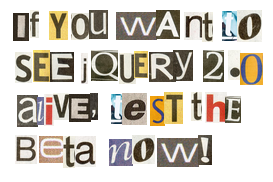With just over a month remaining until the jQuery Foundation heads to the Pacific Northwest for jQuery Portland, the first U.S. jQuery Conference of 2013, we thought we’d take a moment to bring you up to speed on what we’ve been preparing for when we set up camp on Thursday, June 13 and Friday, June 14 at the Oregon Convention Center.
What’s In Store
We had such a great response to our Call For Papers that picking “only” 31 talks was a real challenge! Our goal was to put together a program that has something for developers with all levels of experience across the entire spectrum of front-end development, and we’re really proud of the results (and our amazing speakers, most of whom are presenting at their first jQuery conference). We’ve put together a Twitter list of all our speakers if you want to connect with them in advance.
If you’re out for the latest and greatest, you’ll probably want to spend a lot of your time in Track A, where we’ll be covering (amongst other things) how and when to use native HTML5 and CSS3 solutions to problems often solved with jQuery, mobile and A/B testing strategies, new technologies like WebRTC and Web Components, as well as future plans for selectors and indeed, JavaScript itself.
Track B, on the other hand, is a great place to shore up your foundations and learn where to take your next steps as a developer. We’ll be covering a whole lot, including JavaScript fundamentals, code organization, unit testing, single page applications (and the frameworks often used to build them), Node.js, and avoiding the kinds of small mistakes that can turn into big problems later.
Of course, you’re free to go to whichever sessions you like in either track, and there’s a lot more on offer, including a few sessions on how to learn and teach yourself and your colleagues, as well as keynotes from project leads on the latest developments in the jQuery ecosystem. Take a look at the full program to see all the talks and read the full abstracts.
Tickets & Accommodations
We’ll be selling regular conference tickets until the end of May, at which point we’ll only be selling “late-bird” tickets, which will cost $50 more, so if you’re planning to join us in Portland, you’ll probably want to act now before the price goes up!
jQuery Foundation members will always be able to buy a ticket for the discounted price of $399, so now’s a great time consider joining the jQuery Foundation to show your support and save a bit as well!
There are still hotel rooms available in our room block at the DoubleTree Portland, but the group rate of $144 per night is only guaranteed for reservations made by May 27th.
If you’re looking to bone up on your jQuery skills before the conference begins, we’ve teamed up with Bocoup to hold beginner and advanced training classes on Wednesday, June 12, for which separate tickets (and similar membership discounts) are available.
Sponsors
We’re happy to have the support of the sponsors who have already joined us to help bring jQuery Portland to life, including Splunk, Intel, AppNexus, Automattic, Infragistics, Act-On Software, and Bocoup.
There are still ways to get involved in making jQuery Portland even better, so take a look at our prospectus and get in touch if you (or your company) are interested.
See You There?
We’re really excited about the way jQuery Portland is shaping up and believe that there’s a little bit of something for everyone. (Everyone who reads the jQuery blog, that is!) Follow @jqcon on Twitter for more updates, and hopefully, we’ll see you in a month!



